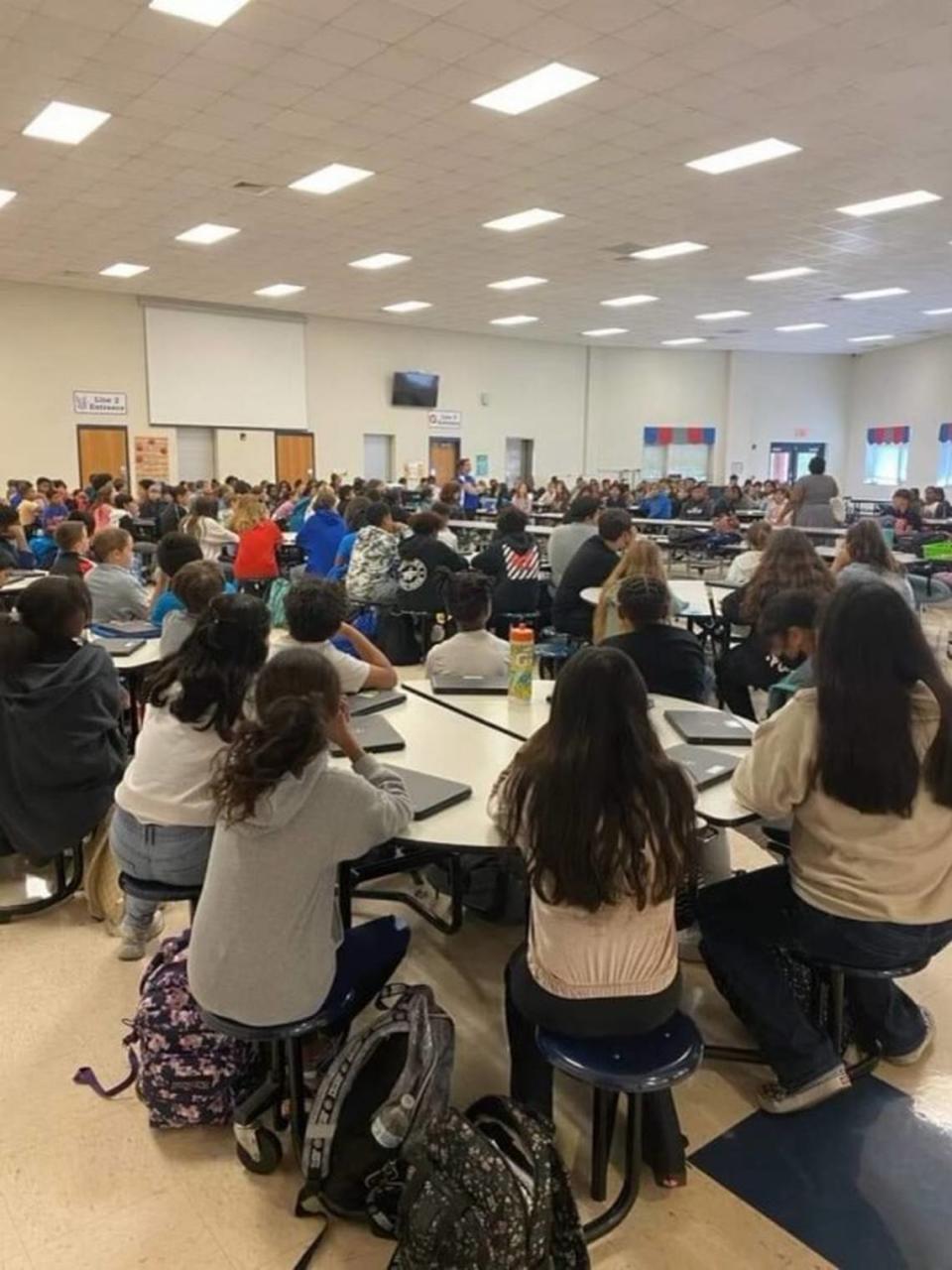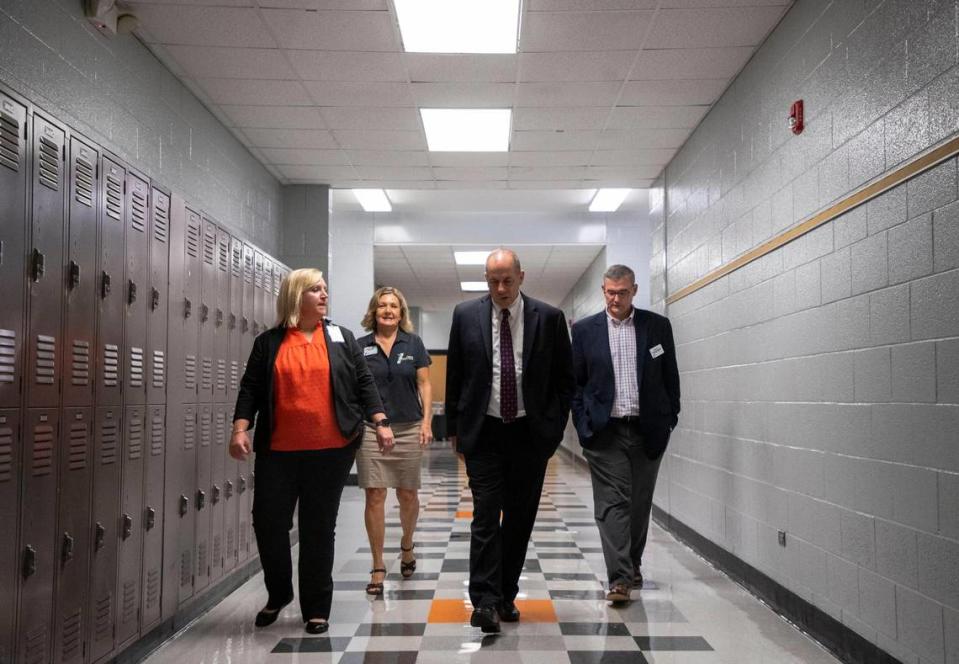Why Cabarrus County’s population growth will force students to move schools
When Kaitlyn Pfuhl and her family moved from Mecklenburg to nearby Cabarrus County, they immediately gained quick access to all the spoils of big-city Charlotte life while enjoying a slower pace in adjacent suburban towns.
It was the best of both worlds.
Three years later, Pfuhl is concerned her young children will face upheaval as Cabarrus County Schools moves closer to executing a systemwide plan to realign district boundaries. The sweeping plan would move between 3,000 and 5,800 students to new schools and suggest new school construction within the district. The expected implementation of any boundary realignments would occur in the fall of 2024.
For parents like Pfhul, that means many students shifting from a neighborhood school to new ones several miles away.
“It will be a lot of time on (the school) bus,” she told The Charlotte Observer. “That would mean losing family time and my children being home more. We’d have to get up earlier and getting home later.”
The change is happening in response to a population surge in Cabarrus County during the past decade. According to the most recent U.S. Census Bureau figures, the area has grown from 178,011 residents in 2010 to 225,804 in 2022. And that’s a trend reflected across the Charlotte region. Cabarrus is one of several counties around Charlotte that has seen its population spike in recent years. Adjacent Iredell County, for example, has grown by 22.2% since 2010, according to the latest population data.
Cabarrus County’s population growth corresponds with a public school enrollment boom — a 21% increase in the same time frame.The district’s current enrollment is about 35,000 students and is projected to exceed 44,000 by 2031, Superintendent John Kopicki said.
Realignment aims for district consistency
The changes are considered necessary to alleviate capacity problems and ensure the district is ready for future growth.
“What we’re trying to do is get some consistency throughout our district to make sure that we can build confidence within our community,” Kopicki said. “When children go to school, they know for the next 10 to 15 years they’re going to this elementary school, this middle school and this high school.”
Over the years, the district handled population growth through mobile units placed near permanent school buildings, but that option will not be helpful in the future. Projections suggest student enrollment will exceed capacity most current school buildings could hold, according to data provided by Cooperative Strategies, a third-party consulting firm used by Cabarrus County Schools to assist with a realignment planning study.

Its analysis projected the school district will need 3,300 more elementary school seats by 2032, Kopicki said. With 11 of 45 schools in the district at or above 100% student capacity, Cabarrus County’s plan includes building new schools.
Seven elementary schools, nine middle schools, and four high schools are currently under 90 percent student capacity, with growth expected to push them over 100% capacity by next year, according to Cooperative Strategies projections.
“We want to make sure that as we prepare for that growth, we utilize our buildings appropriately,” Kopicki said. “The evidence and the data played out that we not only have to realign, but we need a master plan in place, too. So part of the proposal is going to include building some schools down the road.”
But Kopicki indicated that new school construction is contingent upon funding from the Cabarrus County commissioners. Currently, the only construction project underway is the replacement of R. Brown McAllister STEM Elementary School, which will open sometime next fall, Kopicki said.
According to Cooperative Strategies data, building three new elementary schools and a high school and addressing deferred maintenance for current facilities would cost the district around $958 million. Those four new schools would raise the district’s student capacity by several thousand.
Kopicki said that “every school in the system is going to be affected” in some way by realignment.
Options considered under Cabarrus County plan

What change looks like will depend on which proposal recommended by Cooperative Strategies is chosen by the Cabarrus County Board of Education.
The California-based company drafted a trio of boundary options based on criteria that include reducing overcrowding, managing district feeder patterns, travel times, and ensuring schools reflect area demographics.
The first realignment option, or “Scenario A,” described on the CCS website, focuses on filling R. Brown McAllister Elementary School and “slightly addressing feeder patterns from elementary to middle schools.”
It’s a short-term solution that does not “address future growth, align with its facilities master plan proposal and long-range planning efforts,” Cooperative Strategies said.
The second plan would see all district elementary schools except Coltrane-Webb, Mount Pleasant, R. Brown McAllister, and Rocky River rezoned to different boundaries. C.C. Griffin and Concord middle schools would avoid realignment. Under the second plan, all high schools would get new boundaries, except Central Cabarrus and Concord.
The second scenario evenly distributes students across the district but “creates more feeder pattern splits and impacts the largest number of students of any conceptual scenario,” the plan states. ”(It) presents challenges for proximity as well as transportation.”
The final proposal is a longer-term plan that attempts to balance future school construction and account for growth. Elementary schools affected would be A.T. Allen, Charles Boger, Cox Mill, Harrisburg, Hickory Ridge, Mount Pleasant, Patriots, Pitt School Road, Rocky River, W.M. Irvin, Weddington Hills, Winecoff, and Wolf Meadow under that scenario.
All middle schools would see changes except Concord and Hickory Ridge. All high schools, except Hickory Ridge and Concord, would be subject to rezoning.
The third plan touts its ability to provide consistent feeder patterns, more diversity, and impact more students than the first two scenarios.
‘Part of the process’
Even though the school board will not decide until February, district parents are concerned about the impact on their children.
Some took to social media parent groups to express disappointment that the district would consider dramatic changes when students are finally finding post-COVID normalcy. Others fear their children will struggle socially and academically transitioning to another environment away from familiar friends and teachers.
People have been invited to provide feedback about the various scenarios through an online survey and questionnaires on the district website. The district also held public meetings that allowed residents to view the plans as they were presented.
School officials say they’re aware that realignment — regardless of its form — isn’t a one-size-fits-all solution and will create new challenges for families in an attempt to solve others.
Pfuhl’s children, for instance, would be placed in schools more than 35 minutes away from her home under one scenario.
“It is an OK school, but the level of education is different,” said Pfuhl, who is concerned some rezoning situations for families are inequitable.
But Denise Adcock, chair of the Cabarrus County Board of Education, told the Observer implementing realignment now will prevent the district from having to do so again in the future.
“As a board, we understand that change is hard and that it’s going to take a toll on our families who are part of any redistricting,” Adcock said. “Our hope is really to reduce the amount of redistricting that has been necessary over the past decade as our enrollment has grown.
“We understand the toll, but it is part of the process.”
Information about the Cabarrus County Schools realignment plan, including the Cooperative Strategies recommendations, can be found at engagewithccs.com.

